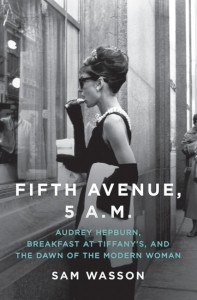Wasson ’03 Writes about Audrey Hepburn and the Making of Breakfast at Tiffany’s

Sam Wasson ‘03 has written a new book, Fifth Avenue, 5 A.M.: Audrey Hepburn, Breakfast at Tiffany’s, and the Dawn of the Modern Woman (HarperCollins), about the making of the beloved 1961 Hollywood classic directed by Blake Edwards and based on the Truman Capote novella. The book was published June 22.
In a recent article about the book in New York magazine, Mary Kaye Schilling writes: “A fascination with fascination is one way of describing Wasson’s interest in a film that not only captures the sedate elegance of a New York long gone, but that continues to entrance as a love story, a style manifesto, and a way to live…Wasson wanted to know the reason for its cultural longevity, and once he started asking, the inevitable answer was Audrey Hepburn. But something about the idolatry bugged him. ‘Hepburn has become a near-saintly figure, untouchable. That didn’t sit well with me. I thought there was a human being there who needed to be looked at.’ “
In Breakfast at Tiffany’s, Hepburn plays Holly Golightly, “a single woman with an active sex life,” which “was suddenly a condition to aspire to.” Truman Capote wanted Marilyn Monroe to be cast in the film because he thought Monroe would be more convincing as the call girl heroine of his novella.
“Before Hepburn, there was the prude and the slut, and the reality of in-between had no cinematic correlation,” says Wasson in New York magazine. “If Monroe had played her, she would have just been a hooker. That was when I got the power of the movie, and the genius of casting Audrey Hepburn.”
In her positive review of the book in The New York Times, Janet Maslin writes: “Sam Wasson’s Fifth Avenue, 5 A.M. is willing to take a fond and incisive look, if not Paramount’s self-importantly tough one. This alluring little book is devoted to the contradictions that pervade Breakfast at Tiffany’s: the contrivances that kept it so frothy, the weirdly backhanded feminist message (Holly was certainly free spirited) and the unusual place occupied by this sprite, her evening gown and her 5 a.m. Fifth Avenue Danish in the history of American film.”
Wasson also is the author of A Splurch in the Kisser: The Movies of Blake Edwards, published by Wesleyan University Press.

